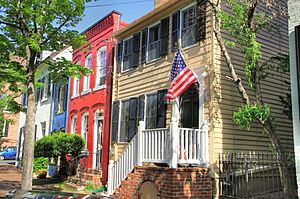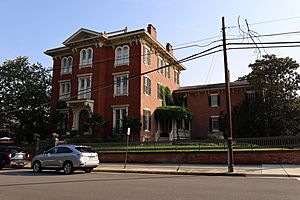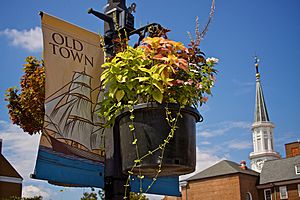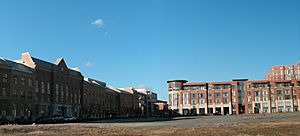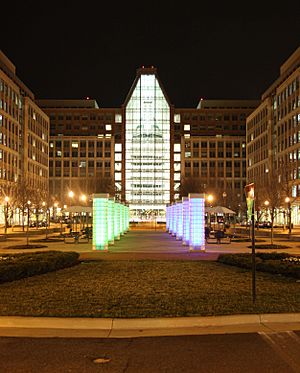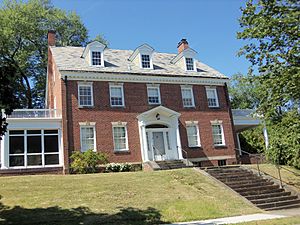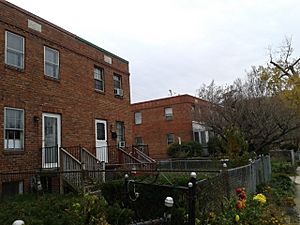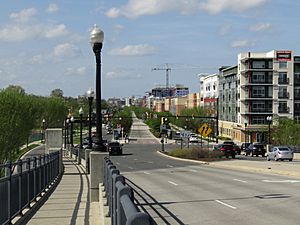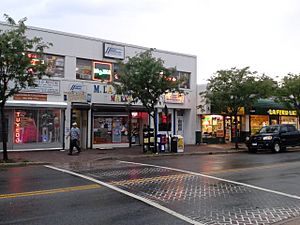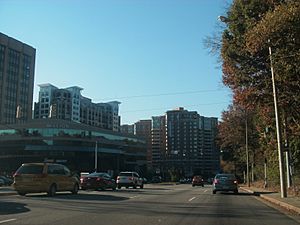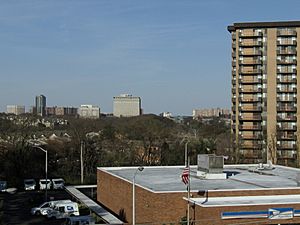Neighborhoods of Alexandria, Virginia facts for kids
Alexandria, Virginia is a special city in Virginia, located right next to the Potomac River. It's home to about 151,000 people and is only about six miles (9.6 kilometers) south of downtown Washington, D.C.. It's a place with lots of history and different neighborhoods, each with its own unique feel!
Contents
- Exploring Alexandria's Neighborhoods
- Old Town: A Step Back in Time
- Eisenhower Valley: From Mills to Modern Hub
- Southwest Quadrant: Historic Cemeteries
- Rosemont: Alexandria's First Planned Homes
- North Ridge: A Residential Gem
- The Berg: A Community's Story
- Parker-Gray: A Rich Black History
- Del Ray: A Lively Community
- Potomac Yard: From Rail to Retail
- Arlandria: A Diverse and Growing Area
- Clover-College Park: Home to a President
- West End: Suburban Living in the City
Exploring Alexandria's Neighborhoods
Alexandria is divided into many different areas for city planning. These areas help the city organize how it grows and develops. Let's explore some of the most interesting ones!
Old Town: A Step Back in Time
Old Town is the oldest part of Alexandria, first planned way back in 1749. It's right by the Potomac River and is famous for its historic houses, art galleries, and antique shops. You'll love walking on its cobblestone streets and red brick sidewalks!
Many famous historical spots are in Old Town. You can see General Robert E. Lee's childhood home, Gadsby's Tavern, and the Stabler-Leadbeater Apothecary Shop. The Torpedo Factory is a cool art studio complex. You can also take river cruises or watch street performers near the water.
Market Square in Old Town has been a marketplace since 1753, making it one of the oldest in the United States. Today, it has a big fountain, beautiful plants, and a farmers' market every Saturday. Alexandria City Hall is also right next to Market Square.
A statue of a soldier, called Appomattox, stood in Old Town for 131 years. It marked where soldiers from Alexandria left to join the army during the American Civil War. The statue was moved in 2020.
Eisenhower Valley: From Mills to Modern Hub
A Look at the Past
Long ago, Native Americans lived in the Eisenhower Valley area. It was once called Cameron Valley and had mills that made flour in the 1790s. One of these mills became a pumping station for water.
Later, in 1850, railroad tracks were built through the land. During World War II, a house called Bush Hill was used to hold an important person. After the war, it became a preschool, but sadly, it burned down in 1977. Today, a historical marker shows where the house once stood.
In the 1950s, a developer named Hubert N. Hoffman saw the area's potential. He bought land, and now a big part of Eisenhower East is the Hoffman Town Center.
By the 1980s, the valley was mostly industrial, with things like a scrap yard and a jail. But by the mid-1990s, it changed a lot with new businesses and homes. The main road here is Eisenhower Avenue, named after President Dwight D. Eisenhower.
Important Places in Eisenhower Valley
The Animal Welfare League of Alexandria is located in Eisenhower West. You can also find Cameron Run Regional Park here, which has a small lake called Lake Cook.
Eisenhower East and Carlyle are important business areas. They are home to the United States Patent and Trademark Office, the National Inventors Hall of Fame, and the Albert V. Bryan U.S. Courthouse. The National Science Foundation also moved here in 2017.
This area also has the Alexandria African American Heritage Park and the Wilkes Street Cemetery Complex. You can easily get around using the Washington Metro at the Eisenhower Avenue station.
Southwest Quadrant: Historic Cemeteries
Right next to Eisenhower Valley is the Wilkes Street Cemetery Complex. It was started in 1804 because the city needed more space for burials. There are 13 cemeteries here, many of which are still active. Some well-known ones include Alexandria National Cemetery and St. Paul's Cemetery. There's also the Alexandria African American Heritage Park, which was once a cemetery.
Rosemont: Alexandria's First Planned Homes
West of Old Town is Rosemont, one of Alexandria's first planned neighborhoods. It was built between 1900 and 1920. Rosemont was meant to be a "streetcar suburb" connected to Washington, D.C., by electric train. Instead, it became a close part of Alexandria.
Rosemont is known for its early 20th-century home styles and its original street plan, which shows ideas from the "City Beautiful movement" of that time. Famous TV weatherman Willard Scott grew up here. Ivy Hill Cemetery is also nearby.
North Ridge: A Residential Gem
North Ridge is in northern Alexandria, close to Arlington County. It's mostly a residential area with many single-family homes built from the 1930s to the early 1960s.
You'll find schools like St. Stephen's & St. Agnes School and Alexandria Country Day School here. There are also many churches and a Scottish Rite temple. Parks like Monticello Park and Beverley Park offer green spaces.
The Berg: A Community's Story
At the northern edge of Old Town, you'll find what's left of a historic African-American community called "The Berg." It was settled in 1861 by people who had escaped slavery.
Two important landmarks in The Berg are the James Bland Homes and the Samuel Madden Homes. These public housing complexes are named after important African-American figures. The neighborhood was even mentioned in the movie Remember the Titans, which is about school integration in the 1970s.
Parker-Gray: A Rich Black History

Parker-Gray is in the northwestern part of Old Town. It's the largest historically black neighborhood in Alexandria, with many small row houses and businesses.
The area is named after the Parker-Gray School, which was the first high school for black students in the city. It opened in 1950. After schools were no longer separated by race, the building became a middle school and later was replaced by townhouses. Today, the Alexandria City Public Schools headquarters is on the site, marked by a plaque.
Buildings in Parker-Gray show different architectural styles from the 1800s, like Greek Revival and Queen Anne. Many public housing units were also built here. The neighborhood was mostly rural for a long time, but during and after the American Civil War, it became a safe place for freed black people.
The Alexandria Black History Museum is in Parker-Gray, in the old Robert Robinson library building. Basketball player Earl Lloyd, the first black player in the National Basketball Association, grew up here.
Del Ray: A Lively Community
Northwest of Old Town is Del Ray, a lively area that was once part of a separate town called Potomac. Del Ray is known for its friendly community and local businesses.
The area started in 1894 with streets laid out in a grid pattern. By 1928, the town of Potomac, which included Del Ray, had over 2,000 residents. Today, more than 20,000 people live in Del Ray!
Del Ray has become more popular over the years, especially since the Potomac Yard Shopping Center opened nearby. Every October, Del Ray hosts its "Art on the Avenue" festival, which brings many people from the Washington, D.C. region.
The Braddock Road Metro station serves southern Del Ray, and the new Potomac Yard station serves the northern parts. Mount Vernon Community School and George Washington Middle School are also located here.
Potomac Yard: From Rail to Retail
Across U.S. Route 1 from Del Ray is Potomac Yard. This area used to be one of the busiest rail yards on the Eastern Seaboard. Now, it has a big shopping center and many homes and businesses.
A new Potomac Yard Metro station opened in 2021. Potomac Yard is also part of "National Landing", a new name for the area that includes parts of Arlington. This area was chosen for part of the Amazon HQ2 company headquarters. Virginia Tech also plans to open an Innovation Campus here.
Arlandria: A Diverse and Growing Area
Arlandria is in the northeastern part of Alexandria, next to Del Ray. Its name comes from "Arlington" and "Alexandria" because it's on the border of both. It's shaped like a rough triangle.
This neighborhood is famous for its many Hispanic, Thai, and Vietnamese bakeries, restaurants, and shops. Many immigrants from El Salvador moved here in the 1980s, earning it the nickname "Chirilagua."
Arlandria is home to the Birchmere concert hall and St. Rita Roman Catholic Church. The city has plans to encourage more development here, and a Latino festival is held yearly at Four Mile Run Park. The song "Arlandria" by the band Foo Fighters is named after this neighborhood, where the band's singer, Dave Grohl, once lived.
Clover-College Park: Home to a President
Clover-College Park is a neighborhood where many streets are named after colleges and universities. It became well-known when Gerald R. Ford, who later became president, lived here as Vice President of the United States. The Ford family stayed in their home for a few days even after he became president in 1974!
Bishop Ireton High School, a Roman Catholic high school, is also located in Clover-College Park.
West End: Suburban Living in the City
Alexandria's West End includes areas that were added from Fairfax County in the 1950s. It feels more like a suburb, with winding roads and cul-de-sacs. The section of Duke Street here is known for its many apartments and shopping centers.
Many immigrants from Ethiopia, Eritrea, Afghanistan, and Pakistan have moved to parts of the West End.
Seminary Hill
Seminary Hill is mostly a residential area with single-family homes. It's near the Virginia Theological Seminary, Episcopal High School, and St. Stephen's & St. Agnes School. Alexandria City High School is also nearby.
Lower Alexandria
South of Duke Street, Lower Alexandria has many small homes, rowhouses, and businesses. There are also industrial areas. The Van Dorn Metro Station here provides easy access to Washington, D.C.
Cameron Station
Cameron Station is a planned community with Colonial-style townhouses and condos. It was built on the site of a former United States Army base that closed in 1995. Before building, the land had to be cleaned up.
Cameron Station is surrounded by city parks like Ben Brenman Park, which has athletic fields and a dog park. Samuel W. Tucker Elementary School is also next to the neighborhood.
Landmark
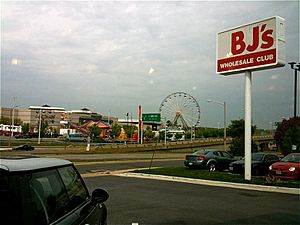
The Landmark area has many apartments and condos. It's also home to the main branch of the Alexandria Library, named after former mayor Chuck Beatley.
Landmark Mall was Alexandria's main shopping area for many years, but it closed in 2017 and is being redeveloped. The city plans to add more shops, homes, offices, and hotels to this area, along with better transportation.
Alexandria West
Alexandria West includes neighborhoods west of I-395. It has a mix of townhomes, single-family homes, senior living centers, and apartments. The Mark Center office development is a large business area here, home to part of the US Department of Defense.
You can also visit two nature preserves in Alexandria West: the Winkler Botanical Reserve and the Dora Kelly Nature Park. The Stonegate area in Alexandria West is the oldest known inhabited site in Alexandria, with evidence of people living there from 3,500 to 1,000 B.C.!
The city has plans to redevelop Alexandria West, which will bring new buildings and better transportation, including bus rapid transit.


